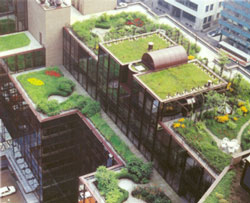
by Hannah Koh
Imagine a menu of apple-smoked whitefish canapés, followed by a salad of tomato, arugula and squash with saltimbocca soup, and a main of veal and beans, and finally dessert, a honey-and-apple cake. All made by Jamie Kennedy.
Mouth-watering, isn’t it?
This is the menu that those who attended the Robert Rose lecture “From the Ground Up” got to experience on September 17th at the Gardiner Museum. The presentation preceding the dinner was about sustainable food sources and urban farms, which has lately become a topic of interest, due in part to rising food costs and the interest consumers have shown in knowing where their food comes from. Jamie Kennedy, as an executive chef who has always promoted the use of local produce and has a farm of his own which he often uses for ingredients for his various restaurants was a natural choice to produce the menu for this particular event. Not only did he supply the ingredients from his farm and other local farms he frequents for ingredients, but he also underscored the point of the evening by using a variety of vegetables grown in an unlikely place: downtown Toronto.
Unbeknownst to many Torontonians, there are actually many urban farms in the GTA, not only on privately owned residential land, but also in fairly public spaces, such as the 550-square-meter plot that supplied some of the vegetables for the Gardiner Museum event, the Sunshine Garden Market, located behind the Centre for Addiction and Mental Health at Queen and Ossington.
There are currently several organizations that are working to promote urban agriculture, such as FoodShare, Matchbox Garden, Seed Co., and The Cutting Veg, and as consumer interest shifts from simply purchasing fresh produce to wanting to know where their food comes from, the interest in the concept of field-to-table food has only intensified and grown. These urban agricultural organizations have allowed consumers to not only purchase organic fresh produce, but are also providing prices that make it more affordable than supermarket-chain organic goods, and consumers are responding by flocking to the numerous farmers’ markets that now take place spring-winter throughout the week in various parts of the city.
So with all this growing interest, why hasn’t urban farming become a bigger phenomenon? As Debbie Field, executive director of FoodShare, said to Toronto Star reporter Kim Honey in a September 15th article, “You can stick your shovel in the ground in Toronto anywhere and grow food…all the soil is Grade 1 agricultural land”. With Toronto located in one of the most fertile strips of land in Ontario, it should stand to reason that it would make sense to devote more urban land to growing produce for our ever-growing city’s population, yet the land devoted to this purpose is miniscule.
It could be argued that one of the main reasons that urban farms haven’t been embraced and championed by the municipal government is due to the fact that Toronto land has such a high value that those who own the land are reluctant to devote it to such a project that wouldn’t yield a high profit. Why grow vegetables that need constant care and attention with potentially low yields of both product and profit when that land can be sold to develop real estate projects that produce an immediate cash-gain to the city/landowner?
The solution for this would be to use the hundreds of city rooftops into “green-roofs” that would then have a double benefit: produce could be grown to provide local vegetables to source-conscious consumers, and also help regulate temperatures during hot summer months in the buildings on which they are located.
Green-roofs work by preventing cool air from escaping through the roof, thus both lowering heating/cooling costs for building occupants and helping the environment by using less energy overall. By growing plants on roofs that would normally be holding in heat during summer months, the heat that beats down on the rooftops is used to grow the plants, instead of heating a building that in turn would normally crank up the a/c to counteract the muggy summer months.
Of course there are the many other obstacles that need to be overcome in order to make this possibility a reality, such as having individuals to plant, care for, and harvest the plants, not to mention sell the produce once it has been harvested, but with growing interest in urban farming and locally grown produce, what seems to only be a distant-reality could become a real possibility much sooner than expected.download tart

Good morning, this was a really high-quality post. I’d like to write like this also – taking time and real effort to make a good article… but what can I say… I procrastinate alot and never seem to get something done.